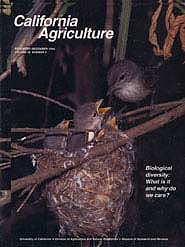All Issues

Biological diversity: What is it and why do we care?
Cover:
Strips of natural landscape along riverbanks can provide wildlife habitat for endangered species such as least Bell's vireo, shown here in the Prado Basin of Southern California. Photo by B. Moose Peterson/WRP
November-December 1995
Volume 49, Number 6
Volume 49, Number 6
News and opinion
PEER-REVIEWED
How economic incentives for growers can benefit biological diversity
Incentives can be modified to reconcile continued profitability of the agricultural industry with sustaining the current biological diversity.





